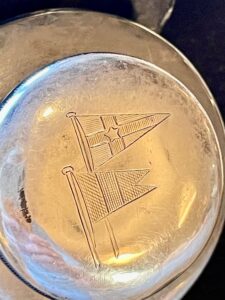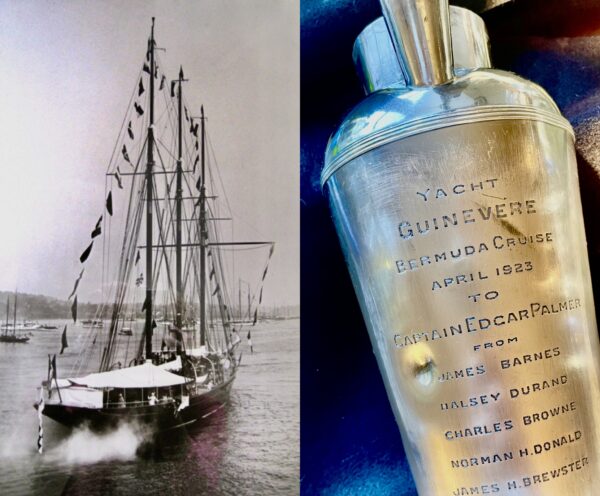Objects help us time travel. One-of-a-kind pieces like this antique cocktail shaker invite us to marvel at a bygone era and envision the circumstances that conjured it into existence – the trip, the camaraderie. Inscribed to Captain Edgar Palmer from his crew, it memorializes a cruise to Bermuda on board the legendary Guinevere. April 1923 was the height of the Prohibition and also the start of the sailing season for many yacht clubs. There is no beginning or end date listed, but evidently the experience merited a really good toast!
So who was Palmer, what was Guinevere and what’s the connection to the Jay Estate? Edgar was the son of a wealthy philanthropist who himself became a benefactor of many institutions. He studied engineering at Princeton, graduating in 1903. He was also a competitive sailor who chose to make the coastal community of Rye his home. In 1911, he and his wife Zilph acquired the Jay Estate on Boston Post Road. Their property which overlooked Long Island Sound was just a boat launch away from “the magical point” of American Yacht Club (AYC) where Edgar would eventually serve as Commodore. Palmer’s 195 foot schooner Guinevere was the club’s flagship from 1915 – 1916 until World War I when she was summoned to volunteer for naval duty and she became “a peace-time swan of the sea that turned hawk.” Many private yachts were similarly conscripted for patriotic duty during the Great War. In order to properly fit her for submarine chasing and convoy patrol, she was painted in camouflage and “40 feet was cut from each of her three 100 foot masts to get her under the Queensboro bridge…she fared forth as flagship of the ‘Easter Egg Fleet.'”
Guinevere’s naval activities as “SP 512” were brief but admirable. Starting in August 1917 she escorted military convoys all along the coast of France. In January 1918, she rescued a ship of men out of thick, pea soup fog, transporting them to safety. But on her return, she rammed into a reef off the coast of Brest, France and was wrecked. With his queen unsalvageable, Palmer commissioned a replica, true in all its proportions, yet fitted with 65 electric motors, one of the first crafts designed with this kind of modern technology. Launched on April 21, 1921 from the Lawley yards at Neponset, the new Guinevere was christened by Edgar’s wife and 12 year old daughter with bouquets of roses and champagne while Palmer’s college friends “started the ‘locomotive cheer of Old Nassau.” Considered at the time to be “the largest sailing yacht in American waters under canvas,” it was this second iteration, fitted with a distinctive tiger bowsprit, that sailed to Bermuda in April 1923.
 A closer look at the pitcher shows Edgar’s private, single-striped signal etched into its stopper (although not its orange and black colors) along with the New York Yacht Club (NYYC) burgee. Equal parts practical barware and keepsake, this polished flagon resurrects a time when martinis and memories of a swell adventure poured freely among friends and fellow sailors, a tradition that survives to this day.
A closer look at the pitcher shows Edgar’s private, single-striped signal etched into its stopper (although not its orange and black colors) along with the New York Yacht Club (NYYC) burgee. Equal parts practical barware and keepsake, this polished flagon resurrects a time when martinis and memories of a swell adventure poured freely among friends and fellow sailors, a tradition that survives to this day.
And it’s in that spirit, that this year’s Jay Soirée will be nautically themed. Sail away with us this September. We’ll be shaking up cocktails and the dance floor in true 1920s fashion! A committee kickoff party, ticket link and more info to come soon.
____________________________
More about the cocktail shaker…
The mates listed on the ewer included 4 of Palmer’s closest Princeton friends: Halsey Durand (Class of 1901), James Barnes (Class of 1891, and a founder of a theatrical group called the Triangle Club), Dr. Charles Browne (Class of 1896), Norman H. Donald of Staten Island, (Class of 1903 – the same year as Palmer) – and one Yalie, James H. Brewster, who lived in Rye. Durand hailed from Newark and had crewed on at least two of Palmer’s other yachts with him – Hester in 1910 and Venona in 1913. Brown was a Democrat, Congressman, and mayor of Princeton, from 1914-1923; he and Donald would both sail with Palmer on Guinevere in the great Santander ocean race to Spain for the King’s Cup in 1928. Palmer and Donald were the closest of the six -perhaps Donald purchased the decanter and arranged the dedication. The hallmark EGW & S on the bottom of the piece identifies the maker of the pitcher as Elizur Webster & Sons whose showroom could be found on Maiden Lane in downtown Manhattan through the 1920s. Spouted dispensers like these were often sold with glasses as a set complete with a cork stopper to stop the precious spirits from spilling out before their time.
